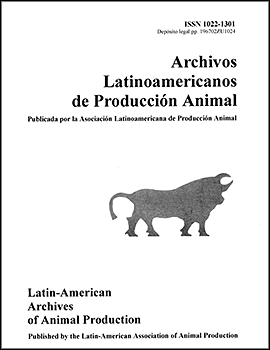
|
Archivos Latinoamericanos de Produccion Animal
Asociacion Latinoamericana de Produccion Animal
ISSN: 1022-1301
EISSN: 1022-1301
Vol. 12, No. 4s1, 2004, pp. 26-31
|
 Bioline Code: la04022
Bioline Code: la04022
Full paper language: Spanish
Document type: Research Article
Document available free of charge
|
|
|
Archivos Latinoamericanos de Produccion Animal, Vol. 12, No. 4s1, 2004, pp. 26-31
| es |
Caracterización morfométrica del ovino Pelibuey local en Yucatàn, México
J. G. Romualdo, A. C. Sierra, J. R. Ortíz, J. S. Hernàndez
Resumen
El ovino Pelibuey del estado de Yucatàn fue caracterizado morfo-métricamente considerando tres bases de datos o estratos procedentes: I. Secretaría de Agricultura, Ganadería, Desarrollo Rural, Pesca y Alimentación; II.Unión Ganadera Local Especializada de Ovinocultores de Mérida; y III.Unión Ganadera Local de Tízimin. De acuerdo a cada estrato se determinó el tamaño de muestra (n) y productores quienes proporcionaron los animales a medir. Un total de 369 individuos mayores de un año, de ambos sexos y con características fenotípicas de la raza fueron seleccionados, y clasificados por estrato y color de capa: café, blancos y pintos. Cinco características fanerópticas y 11 morfo-estructurales fueron registradas por animal. Del anàlisis de datos se obtuvo quetodos los animales tuvieron ojos cafés; la lengua sin pigmentación dominó para el color de capa café (20 %) y blanco (24 %) mientras que para el pinto dominó la lengua pigmentada (66 %). En el color de capa café dominó el color depezuña negro (57 %), en el blanco las claras (68 %) y enel pinto las jaspeadas (75 %). Los tres colores de capa presentaron lana (30 %) y mamellas (2 %). Las diferencias entre estratos en machos de las variables peso vivo, longitud de cabeza, longitud de cuello, longitud de grupa y diàmetro longitudinal, y en hembras longitud de cuello, alzada a la cruz, longitud y ancho de grupa y el perímetro toràcico no fueron estadísticamente significativas (P > 0,05). Por color de capa, el ancho de grupa en machos y el ancho de cabeza en hembras difirieron significativamente (P < 0,05). El coeficiente de correlación màs alto fue entre alzada a la cruz y alzada a la grupa, de 0,92 y 0,87 en machos y hembras respectivamente. Las diferencias encontradas entre estratos estàn condicionadas por el sistema de producción que utiliza cada productor y la poca variación morfo-estructural entre los tres colores de capa evaluados indica que descienden del mismo tronco racial.
Palabras-clave
Small ruminants, Pelibuey sheep, Characteristics, Phaneroptics, Morphostructurals
|
| |
| en |
Morphological characterization of the Pelibuey sheep of Yucatan, Mexico
J. G. Romualdo, A. C. Sierra, J. R. Ortíz, J. S. Hernàndez
Abstract
Three data bases or stratums: I. The Secretariat of Agriculture, Cattle, Rural Development, Fishing and Feeding, II.Specialized Local Cattle association of sheep farmers of Mérida and, III.Local Cattle Union of Tízimin was used to characterize morphometrically the Pelibuey sheep breed of the state of Yucatan, Mexico. Sample size and producer were determined within stratums. A total of 369 animals within breed standards, males and females, and over a year of age were selected and classified by stratum and coat color: coffee, white, and pinto. Five phaneropticaland 11morphostructural characteristics in addition of the body weight were registered by animal. All animals presented coffee eyes, tongue without pigmentation dominates for the coffee (20%) and white (24%) coat colors, whereas for the pinto dominates the pigmented tongue (66%). Black hooves dominate in the coffee coat color individuals (57%), faulty colored hooves in the white (68%), and marbled hooves in the pinto (75%). Wooly (30%) and wattled (2%) individuals were common among coat colors. Differences among stratums of live weight, head length, length of the neck, length of hip, and the longitudinal diameter in males; and neck length, wither height, length of hip, width of hip, and thorax perimeter in the females were not significant (P>0.05). Whereas, hip width in males and head width in females differed significantly among coat colors (P<0.05). The highest correlations for males (0.92) and females (0.87) were for hip height and wither height. Differences found among stratums are associated to differences in the production system. The minimum variation among coat colors indicates that animals come from a common trunk.
Keywords
Small ruminants, Pelibuey sheep, Characteristics, Phaneroptics, Morphostructurals
|
| |
© Copyright 2004 - ALPA. Arch. Latinoam. Prod. Anim.
Alternative site location: http://www.alpa.org.ve/ojs/index.php
|
|
